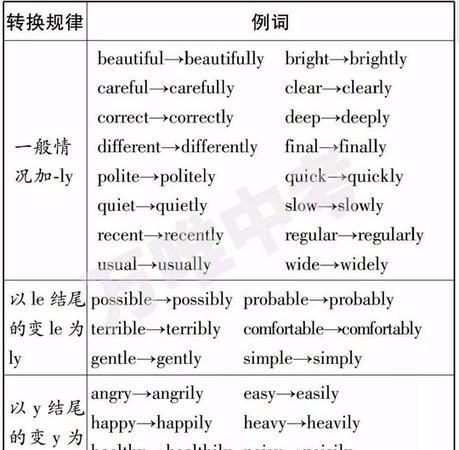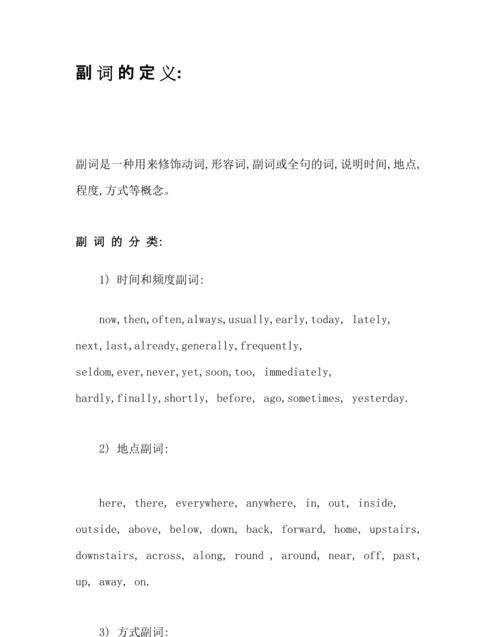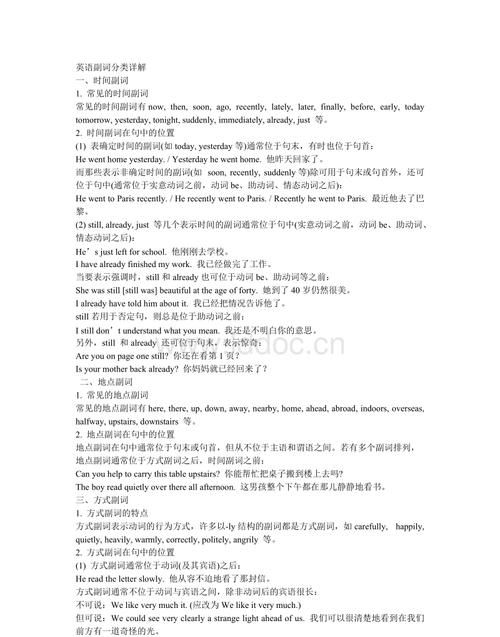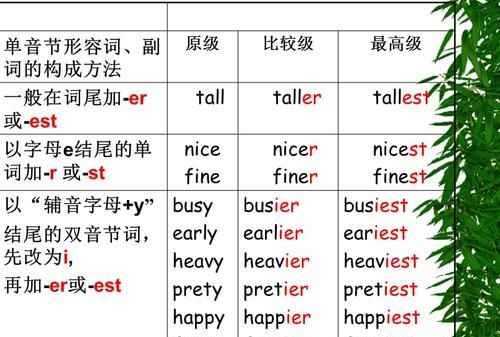本文目录
英语中形容词变副词的规则是什么
副词用来修饰动词,形容词,副词或整个句子.
He run fast.副词fast 修饰动词run
He run very fast.副词very 修饰副词fast
She is very beautiful.副词 very修饰形容词 beautiful
He did his homework carefully.副词carefully 做方式状语修饰整个句子.
副词修饰形容词或副词时放在所修饰词前.
副词修饰动词时放在动词之后,如果动词带有宾语,那么副词放在宾语之后.
频度副词(如:often,usually)放在be动词、助动词、情态动词后,实义动词前.

英语中副词的用法和位置
英语副词是对动词、形容词、其他副词或者一个句子起描述作用,或者对其意义作进一步说明的词.英语副词根据其句法功能可分为附加语(adjunct)、联加语(conjunct)和外加语(disjunct).各类副词在句中的位置各不相同,变换其词序会使句子的含义产生变化.下面笔者对副词的用法进行分类说明.
一、 附加语
附加语为分句或句子基本结构的一部分,在分句或句子中修饰动词、形容词或其他副词,表示时间、地点、频率、程度或方式.如:
(1) I have almost finished. 我已经差不多完成了。
(2) I think she'll be married shortly. 我想她不久就会结婚的。
(3) He was a deeply sick man. 他病得相当严重。
(4) He did really well, didn't he? 他做得相当好,不是吗?
附加语还可细分为两类:主语附加语(subject adjunct)和方式附加语(manner adjunct)。如:
(5) You stupidly answered his questions. ( stupidly 是主语附加语.这句话的含义相当于:It was stupid of you to answer his questions. 或 You were stupid to answer his questions.)
(6) You answered his questions stupidly. (stupidly是方式附加语.这句话的含义相当于:You answered his questions in that stupid way.)
附加语可以放在被修饰词的前面或句末,附加语的位置不同其含义也不同。试比较下列各组句子:
(7) We have solved practically all these problems. 这些问题我们差不多已全部解决了。
We have solved all these problems practically. 我们以切实可行的方法把全部问题解决了。
(8) We heard only of it this morning. 今天早上我们只听见这件事。
We only heard of it this morning. 我们今天早上只是听说这件事。
We heard of it only this morning. 我们只是在今天早上才听说这件事。
二、联加语
联加语不属于分句或句子的基本结构,只是用来表明含该联加语的句子与其他句子的关系。如:
(9) Altogether, it was a happy week. 总的说来,这星期是开心的。
(10) It rained; therefore, the match was postponed.因为下雨,所以比赛延期了。
大家都知道,定语从句中的关系代词that与which在指物时,往往是可以互换的,但在下列几种情况下却多用关系代词that,而不能用which.
1. 当先行词为all, little, much, few, everything, none 等不定代词时,关系代词用that而不用which.例如:
All that glitters is not gold.
There are few books that you can read in this book store.
2. 当先行词既有人又有物时,关系代词用that, 不用which.例如:
He asked about the factories and workers that he had visited.
3. 当先行词有形容词最高级修饰时,关系代词用that, 而不用which.例如:
It was the largest map that I ever saw.
Hangzhou is one of the most beautiful cities that I have ever visited.
4. 当先行词有序数词修饰时,关系代词用that, 不用which.例如:
The first sight that was caught at the Great Wall has made a lasting impression on him.
5. 当先行词被the only, the very, the same, the right等修饰时,关系代词用that,不用which.例如:
That is the very thing that we can do. It is the only book that he bought himself.
6. 当先行词被all, every, any, much, little, few, no等修饰时,关系代词用that,不用which.例如:
You can take any book that you like.
7. 当主句是以which开头的特殊问句时,为了避免重复,定语从句的关系代词一般用that,而不用which.例如:
Which was the hotel that was recommended to you?
8. 在强调句型" It is ... that ..."中, 只能用that,不能用which.例如:
It was liberation that brought about a complete change in his life.
9. 在"such (the same) ... as ..."句型中,关系代词要用as, 而不用which.例如:
We need such materials as (not which) can bear high temperature.
10. as引导的定语从句可以放在主句前面, 也可以放在主句后面或主句中间,而由 which引导的定语从句只能放在主句后面.例如:
As we all know, oceans cover more than 70% of the earth.
(文/陈昌勇 英语辅导报大学一年级版03~04学年第41期;版权归英语辅导报社所有,独家网络合作伙伴新浪教育,未经许可,不得以任何形式进行转载。)

什么时候用到关系副词
副词主要用来修饰动词,形容词,副词或其他结构。 一、副词的位置 1) 在动词之前。 2) 在be动词、助动词之后。 3) 多个助动词时,副词一般放在第一个助动词后。注意: a. 大多数方式副词位于句尾,但宾语过长,副词可以提前,以使句子平衡。例如: We could see very clearly a strange light ahead of us.我们清楚地看到前面有奇怪的光。 b. 方式副词well,badly,hard等只放在句尾。例如: He speaks English well. 他英语说得好。 二、副词的排列顺序: 1) 时间,地点副词,小单位的在前,大单位在后。 2) 方式副词,短的在前,长的在后,并用and或but等连词连接。例如: Please write slowly and carefully. 请写得慢一些,仔细一些 3) 多个不同副词排列:程度+地点+方式+时间副词。注意:副词very 可以修饰形容词,但不能修饰动词。 改错:(错) I very like English. (对) I like English very much. 注意:副词enough要放在形容词的后面,形容词enough放在名词前后都可。例如: I don't know him well enough. 他我不熟悉。 There is enough food for everyone to eat.有足够的食物供每个人吃。 There is food enough for everyone to eat.

英语在什么情况下用副词呢
1.一般副词主要分为以下几种: ①.时间副词, 如: often, always, early, now ②.地点副词, 如: here, there, above, outside ③.方式副词, 如: hard, well, badly, fast, slowly ④.程度副词, 如: very, quite, much, still, almost 2.疑问副词(放在特殊疑问句的句首), 如: how, when, where, why 3.关系副词(放在定语从句句首), 如: when, where, why 4.连接副词(放在名词从句句首), 如: how, when, where, why, whether 二.副词在句中的作用: 副词修饰动词, 形容词, 名词, 副词或全句, 在句中的作用如下 1.作状语: a. You should always review your lessons. b. The visitors are warmly welcomed by the students. c. Certainly we should try out best to improve our work. 2.作表语: a. He is abroad. b. The class is over. c. The football match is on. 3.作定语: 副词作定语时置于被修饰词之后 a. This is her first day up. b. The comrades here give us a lot of help. 4.作补语(包括宾语补足语和主语补足语): a. I found all the lights on when I got home last night. 三.副词在句中的位置: 1.时间副词和地点副词的位置: ①.表示确定时间的副词和表示地点的副词一般放在句尾. 若句中同时有地点副词和时间副词, 地点副词通常在前, 时间副词在后 a. They went to the Summer Palace yesterday. b. We often goes there. c. I will go there tomorrow. ②.表示不确定时间的副词(如: always, usually, often, never, ever, seldom, sometimes, rarely, generally, frequently)的位置: 句子谓语是be时, 位于其后; 句子谓语是单个完全动词时, 位于其前; 句子谓语由不完全动词与完全动词一起组成时, 位于第一个不完全动词之后. a. She always helps her mother with the housework. b. The old man seldom goes out. c. He is always the first to come to class. d. They have already done their homework. 2.程度副词除enough之外, 一般放在被修饰词之前 a. The student is very careful with his work. b. He swims quite well. c. The boy is old enough to go to school. 3.方式副词的位置: ①.修饰不及物动词的方式副词要放在被修饰词之后 a. His sister sings well. b. The baby is sleeping soundly. ②.修饰及物动词的方式副词可放在被修饰词之前或宾语之后; 如果宾语较长, 也可放在动词和宾语之间 a. He speaks French fluently. b. All this morning Liu Ying has been writing carefully some English letters to her teachers. 4.及物动词和副词小品词(down, on, off, in, out, up)组成的动词词组有名词作宾语时, 该名词可放在副词之后或副词之前; 若有代词作宾语时, 则代词一定放在副词之前 a. He cut down the tree. =He cut the tree down. b. He cut it down. 5.修饰名词的副词放在被修饰词之后 a. The villagers there are busy getting in wheat. 6.修饰全句的副词通常放在句首 a. Truly he is an honest man. b. Still, in spite of what you say, I don’t think it is true. 7.作状语时,各类副词的排列顺序一般为: 方式副词, 地点副词, 时间副词 a. He behaved well here yesterday.

以上就是关于英语中什么情况下用副词,英语中形容词变副词的规则是什么的全部内容,以及英语中什么情况下用副词 的相关内容,希望能够帮到您。
